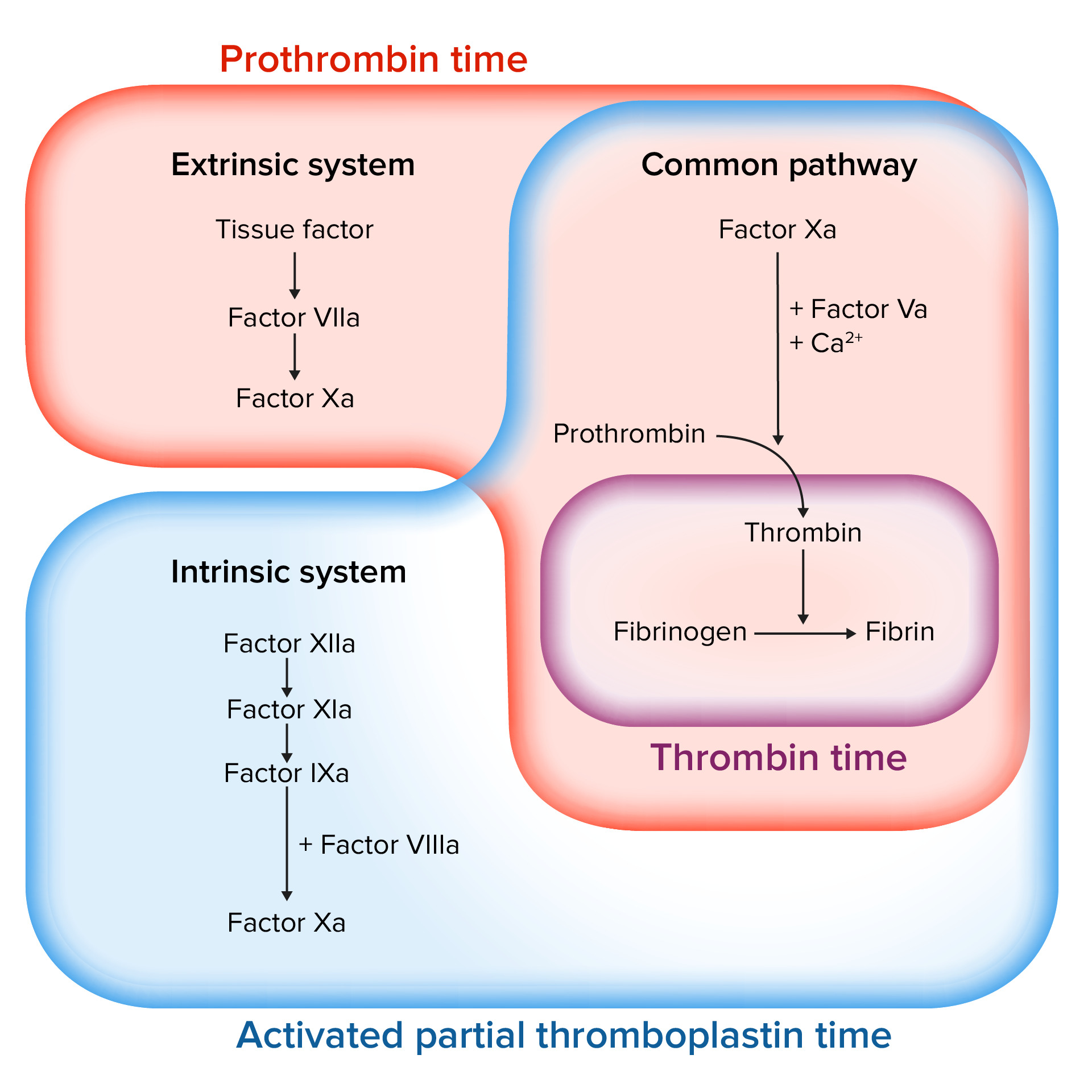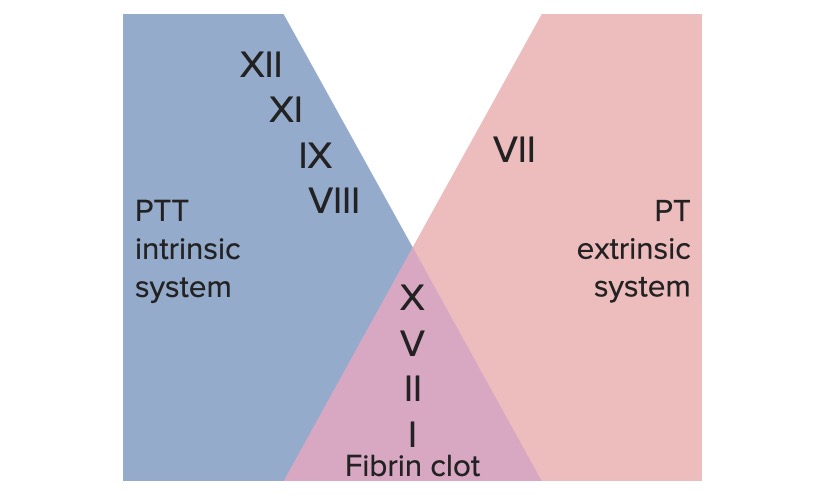Playlist
Show Playlist
Hide Playlist
Prothrombin Time (PT) and Partial Thromboplastin Time (PTT)
-
Slides Measuring Clotting Parameters.pdf
-
Download Lecture Overview
00:01 Oh boy, now we're back to coagulation factors. 00:05 And remember, the intrinsic pathway, that's driven off a negatively charged surface. 00:10 Remember, the extrinsic pathway, that starts with tissue factor, otherwise known as thromboplastin or as factor III and then we get to the final common pathway and we activate prothrombin it becomes thrombin, we cleave fibrinogen to become fibrin, we crosslink it with XIII. 00:26 Yeah, you now know that in your sleep and probably wakes you up with nightmares. 00:31 Okay, but now we need to measure various aspects of this and another reason that we have conveniently divided things into an intrinsic pathway and an extrinsic pathway, is because, our different clotting parameters, our different tests, will look at those somewhat independently. 00:49 So, measuring coagulation. 00:52 The, PTT, remember we talked about the PT and PTT. 00:55 Partial thromboplastin time, will look primarily at the intrinsic pathway. 01:00 It clearly also involves components of the final common pathway, just by virtue of the way we do the test and we'll talk about that momentarily. 01:08 So that's the PTT, the intrinsic pathway. 01:12 And then we have the prothrombin time or PT, which looks at primarily, the extrinsic pathway and again, there's overlap, both of these times, both of these clotting parameters that we can measure in the laboratory. 01:27 We'll also look at prothrombin activity and fibrinogen cleaving et cetera. 01:33 Okay, let's look at these in a little bit more detail. 01:37 We'll start first, with a prothrombin time and again prothrombin time, that's going to be looking at mostly the extrinsic pathway. 01:45 So, when we first described this back in 1935, only prothrombin or factor II was known, so that's why it has got that name as prothrombin time and basically, we would take the patient's plasma, notably, take a step back, in all of these coagulation measurements, we have to draw the patient's blood in such a way, that we prevent it from clotting in the test tube. 02:10 If I simply take your blood, suck it up into a test tube, leave it on the shelf, it will clot. 02:15 The coagulation factors will get stochastically activated and you're off and running and over a period of time they will clot. 02:23 So, we inhibit the clotting when we draw the blood, by putting in a chelator of calcium, ethylenediaminetetraacetic, EDTA, is commonly used. 02:35 Citrate is commonly used and what that does is, it sucks up all the calcium, that's in the blood and prevents the from clotting in the test tube until we're ready. 02:44 Okay, so, we take the patient's blood and it’s not clotted because we've added that chelator, we spin down all the red cells, we spin down all the platelets and all we have left is the protein, the plasma on top. 02:56 We take that into a separate tube or tray, we add back calcium and then we add the start component, in this case, because it's the extrinsic pathway, we're giving back thromboplastin, we're giving back tissue factor, factor III. 03:14 And what is that? So, it's a tissue extract, originally it was from rabbit brains, interestingly enough, but it contains a lot of phospholipid and it contains a lot of tissue factor. 03:23 Okay and so we take the plasma, we add back calcium, we give that thromboplastin and we start our stopwatch and then we measure how long it takes to get a clot and it all begins with that factor VII activation, interacting because of the thromboplastin or the tissue factor. 03:42 And it measures, factors III, that's the thromboplastin or tissue factor, factor VII, X, V, II, and I. 03:50 And it gets it gives us a time it's usually in the ballpark of 12 seconds or thereabouts and we express it, as an international normalization ratio or “INR.” So, in other words, we will take a completely normal person and we'll see how long it takes to get clotting through this pathway and then we'll take the unknown sample from a patient and we'll see how long it takes and then we'll compare that as a ratio and normally 1, is where you want to be, because that means you're normal, if it's longer than one, then you have abnormal clotting and sometimes, that's because, we've administered therapy to make it abnormal and sometimes it's because you have other problems. 04:34 We typically use, the INR from the prothrombin time, to assess coumadin therapy and coumadin is a factor K antagonist, that we'll talk about subsequently in another session, that blocks the synthesis of factors II, VII, IX, and X. 04:54 So, important in this. Okay. 04:58 So that's prothrombin time. 05:00 Let's look on the other side, how are we going to measure the intrinsic pathway components? and this is the partial thromboplastin time or PTT. 05:09 Okay, so when this was first described, this is mid 40s. 05:14 Partial thromboplastin had phospholipid in it, but didn't have tissue factors, so it wasn't called, it wasn't the same test as the prothrombin time, which looked at tissue factor activation of the extrinsic pathway. 05:27 Again, what are we doing? So, we take the patient plasma again, it's anticoagulated, so we have we have chelated up all the calcium and now we add back calcium and we add back phospholipid and normally the phospholipid in the normal scheme of things, would be provided by the platelet plasma membrane or by the polyphosphates being secreted by platelets and then we add an intrinsic pathway activator. 05:56 And in most laboratories, that's just a glass bead, it's a surface upon which the things can occur, so that's how we actually do the test and the intrinsic pathway measures the time to form a clot after that factor XII activation, factor XII is being activated by those glass beads and then in the presence of the phospholipid and the calcium, we go through the intrinsic pathway and get a clot. 06:22 So, we want to convert fibrinogen into fibrin and what we're measuring here is, factors: XII, XI, IX, VIII, X, V, II, and I. 06:31 And we commonly use this to assess the efficacy of heparin therapy, remember in the previous session, we talked about giving heparin because it interacts with antithrombin III, which blocks, some of the components of the intrinsic pathway. 06:48 To see how well we're doing with our heparin therapy, we can do a partial thromboplastin time or a PTT test. 06:56 Okay, so we have the extrinsic pathway through PT, we have the intrinsic pathway through the partial thromboplastin time, we use the PT to assess the efficacy of coumadin therapy, we use partial thromboplastin time, PTT, to assess the efficacy of heparin. 07:14 And with that, you've gotten the gist of how we measure coagulation factors.
About the Lecture
The lecture Prothrombin Time (PT) and Partial Thromboplastin Time (PTT) by Richard Mitchell, MD, PhD is from the course Hemostasis.
Included Quiz Questions
What substance is used to prevent blood from clotting in vitro?
- EDTA
- Plasma
- Serum
- Calcium
- Iron
What might the INR be in a patient who is on therapeutic anticoagulants?
- 2
- 1
- 0.75
- 0.9
- 0.5
PTT is particularly useful to measure which of the following?
- Intrinsic pathway
- Extrinsic pathway
- Factors III, VII
- Common pathway
- Fibrin degradation products
PTT has to be monitored in patients who are on which drug?
- Heparin
- Aspirin
- Warfarin
- Rivaroxaban
- Clopidogrel
Customer reviews
5,0 of 5 stars
| 5 Stars |
|
5 |
| 4 Stars |
|
0 |
| 3 Stars |
|
0 |
| 2 Stars |
|
0 |
| 1 Star |
|
0 |





